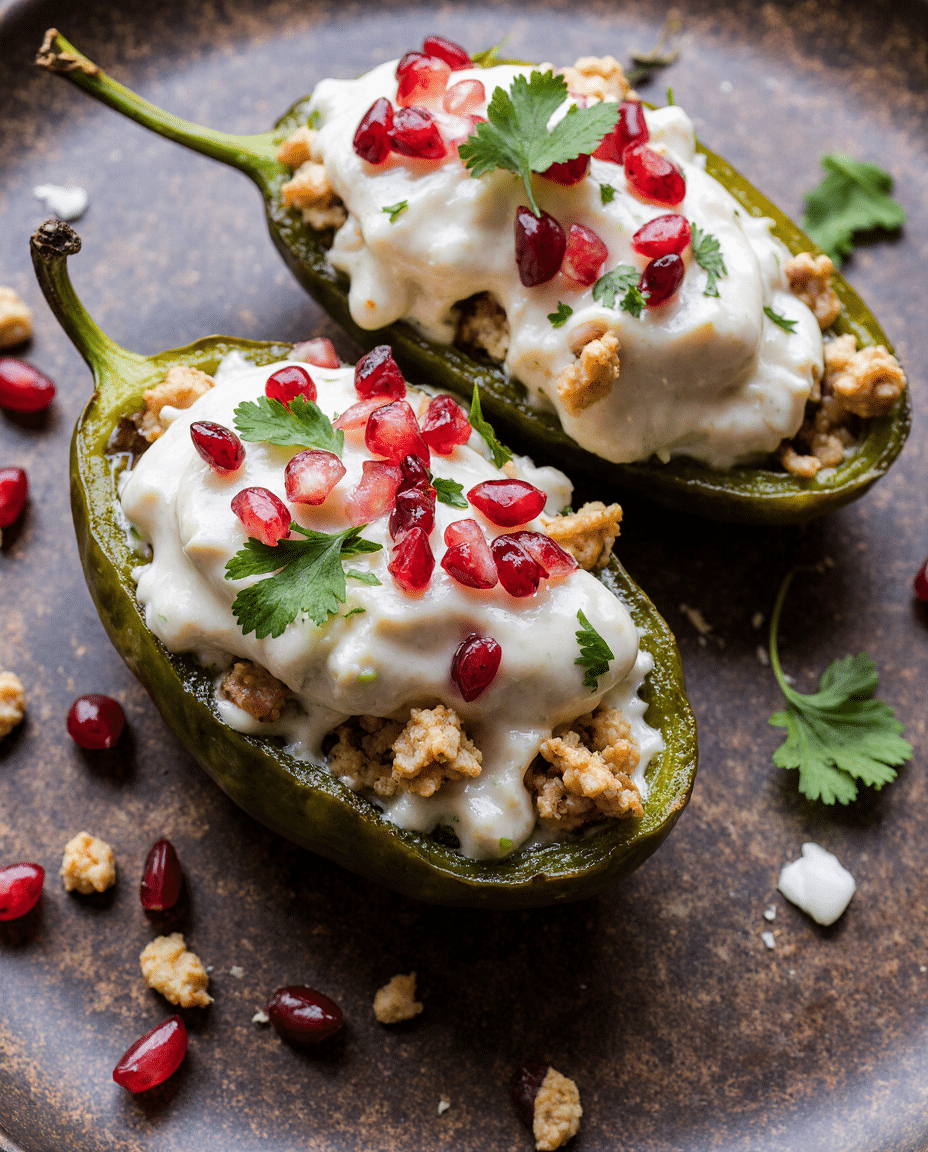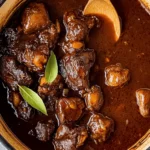Chiles en Nogada is one of Mexico’s most iconic dishes, especially celebrated during Mexican Independence Day in September. This patriotic dish features large poblano peppers stuffed with a sweet-and-savory picadillo made from ground meat, fruits, and spices, all topped with a creamy walnut sauce and garnished with fresh pomegranate seeds and parsley.
FULL RECIPE
Ingredients
1.For the Chiles:
- 6 large poblano peppers
- Vegetable oil (for roasting or frying, optional)
2.For the Picadillo Filling:
- 1 lb ground pork or beef (or a combination)
- 1 small onion, finely chopped
- 2 cloves garlic, minced
- 1 large tomato, peeled and chopped
- 1/2 cup raisins
- 1/2 cup chopped dried apricots or peaches
- 1/2 cup chopped almonds or walnuts
- 1 small apple, peeled and diced
- 1 small pear, peeled and diced
- 1/2 teaspoon cinnamon
- 1/4 teaspoon ground cloves
- Salt and pepper to taste
- 2 tablespoons olive oil
3.For the Nogada (Walnut Sauce):
- 1 cup shelled walnuts (soaked in milk or water for at least 2 hours, then drained)
- 1/2 cup milk (or more to adjust consistency)
- 1/2 cup Mexican crema or sour cream
- 1/4 cup fresh cheese (queso fresco or cream cheese)
- 1 tablespoon sugar (optional, to taste)
- A pinch of salt
- A dash of sherry or white wine (optional, for depth of flavor)
4.For Garnish:
- 1/2 cup pomegranate seeds
- Fresh parsley leaves, chopped
Directions
- Roast the poblanos: Place poblano peppers directly over a gas flame or under a broiler, turning until charred on all sides. Transfer to a bowl, cover with plastic wrap or a towel, and let steam for 10 minutes. Peel off skins, then carefully make a slit in each and remove the seeds, keeping the peppers whole.
- Prepare the filling: In a large skillet, heat olive oil over medium heat. Add onions and garlic, sautéing until translucent. Add ground meat and cook until browned. Stir in tomato, raisins, chopped fruits, almonds, and spices. Season with salt and pepper. Simmer for 10–15 minutes until mixture is well combined and slightly thickened. Allow to cool slightly.
- Make the walnut sauce (Nogada): Blend soaked walnuts with milk, crema, cheese, sugar, salt, and sherry (if using) until smooth. Add more milk to achieve a pourable consistency. Taste and adjust sweetness or salt as needed. Chill until ready to use.
- Stuff the peppers: Gently stuff each poblano with the picadillo mixture, being careful not to tear them. You may secure with toothpicks if necessary.
- Plate and serve: Place the stuffed peppers on a plate. Generously spoon the chilled nogada sauce over each pepper. Sprinkle with pomegranate seeds and garnish with chopped parsley.
- Optional presentation tip: Serve with a side of white rice or fresh bolillo bread for a full meal experience.
Nutrition Facts
- Calories: 450
- Total Fat: 28g
- Saturated Fat: 9g
- Cholesterol: 70mg
- Sodium: 390mg
- Total Carbohydrates: 29g
- Dietary Fiber: 6g
- Sugars: 12g
- Protein: 21g
- Vitamin A: 20% DV
- Vitamin C: 90% DV
- Calcium: 10% DV
- Iron: 15% DV
Historical Significance of Chiles en Nogada
Chiles en Nogada is one of Mexico’s most symbolic dishes, rooted in national history and patriotism. It was first served in 1821 by nuns in Puebla to honor General Agustín de Iturbide after the signing of the Treaty of Córdoba, which marked the end of Spanish rule. The dish’s colors—green poblano peppers, white walnut sauce, and red pomegranate seeds—represent the Mexican flag. Today, it remains an essential part of Independence Day celebrations, blending culinary artistry with cultural pride in every bite.
Seasonality and Ingredient Availability
Traditionally, Chiles en Nogada is made in late summer and early fall, as this is when key ingredients like fresh walnuts, pomegranates, and poblano peppers are at their peak in Mexico. The seasonality is part of what makes the dish special—it’s not something that’s eaten year-round, adding to its festive status. Those preparing it outside this window may need to source frozen or imported ingredients or adjust their timing to coincide with local availability. Using fresh, ripe produce ensures the flavors are vibrant and authentic.
Nutritional Value and Health Insights
Despite its richness, Chiles en Nogada offers a variety of nutrients. The poblano peppers are rich in vitamin C and fiber, while the picadillo filling provides protein, iron, and potassium from the meat and fruits. Walnuts used in the nogada sauce are an excellent source of omega-3 fatty acids, beneficial for heart and brain health. However, due to the use of cream, cheese, and sometimes sugar in the sauce, the dish can be high in calories and fat. Those seeking a lighter version can substitute low-fat dairy or reduce the portion of sauce.
Vegetarian and Modern Variations
While the classic recipe features a meat-based picadillo, modern adaptations often cater to vegetarian or vegan diets. For a vegetarian version, ground meat can be replaced with lentils, tofu, or plant-based protein. Vegan cream and cheese substitutes can also be used in the walnut sauce. Some chefs experiment with different nuts like cashews or macadamia if walnuts are unavailable. These innovations allow for greater accessibility while still honoring the dish’s traditional structure and patriotic presentation.
Tips for Perfect Roasting and Peeling Poblanos
Roasting poblano peppers is a crucial step that develops the dish’s signature smoky flavor. For best results, roast the peppers over an open flame or under a broiler until the skins blister and blacken evenly. After roasting, sealing them in a covered bowl or plastic bag for several minutes helps loosen the skin for easy peeling. It’s important to remove the seeds and membranes gently to preserve the shape of the pepper, as it will be stuffed and topped with sauce. Proper preparation of the peppers sets the foundation for a beautiful and balanced dish.
Presentation and Serving Tips
Chiles en Nogada is not only a culinary delight but also a visual feast. To emphasize its patriotic theme, it is traditionally plated with care—placing the pepper at the center of the plate, generously covering it with the white nogada sauce, and sprinkling pomegranate seeds across the top. A final touch of chopped parsley or cilantro adds the vibrant green accent. Serving the dish at room temperature or slightly chilled helps preserve the flavors and textures, especially the walnut sauce, which is meant to be creamy and cool.
Pairing Suggestions for a Complete Meal
This rich and flavorful dish pairs well with a range of beverages and side dishes. A light Mexican white wine or sparkling water with lime complements the sweetness of the fruit-studded picadillo. For a more festive pairing, try horchata or a mild fruit agua fresca. As a side, fluffy white rice, lightly seasoned black beans, or fresh bolillo rolls make excellent accompaniments. Because the dish is quite filling and complex, lighter sides and drinks help balance the meal and keep the focus on the main attraction.
Storage and Leftover Use
Chiles en Nogada can be made ahead and stored for later, which is helpful when preparing for a celebration. The stuffed peppers can be kept in the refrigerator for up to 3 days in an airtight container. The nogada sauce should be stored separately and added just before serving to maintain its texture. Leftover filling can be repurposed in tacos or empanadas, while the sauce can double as a dip or drizzle for roasted vegetables. Freezing is not recommended due to the dairy in the sauce, which may separate when thawed.
Balancing Sweet and Savory Flavors
One of the defining features of Chiles en Nogada is its expertly balanced sweet and savory profile. The combination of ground meat with fruits like apples, raisins, and dried apricots creates a complex filling that contrasts beautifully with the creamy walnut sauce. Spices such as cinnamon and cloves add warmth and depth. Achieving harmony between these components is essential—too much sugar can make the dish cloying, while an overly savory filling might overpower the delicate sweetness of the nogada and pomegranate seeds.
Advertisement
Why Chiles en Nogada Is a Celebration Dish
This dish’s labor-intensive nature and elegant appearance make it ideal for special occasions rather than everyday meals. From roasting and peeling the poblanos to preparing the elaborate filling and blending the walnut sauce, each step requires attention to detail. But the result is a dish that honors tradition, celebrates family and heritage, and delights both the eye and palate. Sharing Chiles en Nogada at the table is a gesture of pride and hospitality, often reserved for national holidays, weddings, or family reunions.
Conclusion
Chiles en Nogada is a vibrant embodiment of Mexican culinary artistry and patriotism. Its tri-colored presentation pays homage to the national flag, while its layers of flavor showcase the sophistication of traditional ingredients and techniques. Whether prepared in a classic or modernized form, this dish offers a rich, memorable experience rooted in history and celebration. From its nutritional value to its symbolic significance, Chiles en Nogada continues to be a festive, flavorful centerpiece that brings people together in honor of culture, country, and cuisine.






